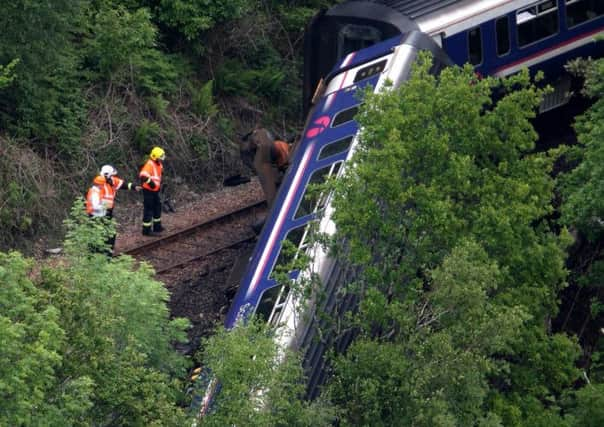Rail warning system “ears” can hear landslide


The fibre-optic cables are a modern-day replacement for a Victorian rockfall warning system in the steep-sided Pass of Brander on the Glasgow-Oban line.
The UK first is being tested on the route below Ben Cruachan, where in 2010 a ScotRail train nearly plunged down a 50ft embankment after hitting a fallen boulder and derailing.
Advertisement
Hide AdAdvertisement
Hide AdA tripwire system built by engineer John Anderson in 1882, in which falling rocks trigger line-side signals, did not detect the boulder because it fell from lower down the slope.
The “stone signals” – a vertical screen of ten horizontal steel wires – are known as Anderson’s Piano because of the humming sound of the wires in the wind.
In 2012, a ScotRail train hit debris from a nearby landslide – one of two incidents in Scotland the same day. Three weeks earlier, a freight locomotive crashed down a hillside near Corrour in the Highlands after hitting landslip debris.
Network Rail Scotland said its novel “distributed acoustic sensing” (Das) scheme could also be deployed to warn of trees falling on tracks, and landslides on roads such as at the landslide-stricken Rest and Be Thankful on the A83 in Argyll.
In 2012, dozens of trees were blown on to a 300-yard stretch of line at Markinch in Fife.
The Das scheme involves cables being buried just below the surface on either side of the single-track line for six miles between near Falls of Cruachan and Loch Awe stations.
The track firm said the system, which is monitored from a signalling centre, was sensitive enough to distinguish between obstacles falling on the line and other noises such as trains, deer and hailstones.
It said the new technology could offer a cheaper alternative to maintaining Anderson’s Piano and other anti-landslide measures such as netting slopes and removing rocks, which often require line closures.
Advertisement
Hide AdAdvertisement
Hide AdAlan Ross, director of route asset management, said: “Rockfalls and landslips are one of the railway’s longest-standing risks and we are always looking at ways we can use new technology to solve old problems.
“The new acoustic monitoring technology on trial offers us a potential solution to a problem which has affected the West Highland lines since they were built by the Victorians.
“If successful, this new system will help us provide an even safer and more reliable railway on a line vital to both the local communities it serves and to Scotland’s tourist trade.”
A ScotRail spokeswoman said: “We are aware Network Rail has begun trials of a new acoustic system.
“We welcome this initiative as, if successful, it will aid in the delivery of a more reliable, consistent and safe railway.”
The Office of Rail Regulation has previously instructed Network Rail to improve its assessment of landslide risks to speed up its response to incidents.
A spokesman for the watchdog said “The regulator supports Network Rail’s work to develop, and introduce, new technology for monitoring the condition of its infrastructure.
“That is why we approved £95 million of funding for the implementation of remote condition testing for earthworks, signalling equipment, level crossings and other assets over the next five years.”
Advertisement
Hide AdAdvertisement
Hide AdA spokeswoman for the Scottish Government’s Transport Scotland agency, which is responsible for the Scottish trunk road network, said: “We are aware of the work at the Pass of Brander.
“We are interested in any technique that improves detection of falling rocks.”